Amazing Baikal – Deepest and Cleanest Lake on Earth
Lake Baikal is the deepest and possibly the oldest lake in the world – it is about 25 million years old. This lake is the hero of myths and legends, the center of shamanism, and an attraction for tourists from all over the world. Since 1996, the Baikal has been included in the UNESCO World Heritage List. Our story today is dedicated to this miracle of nature.
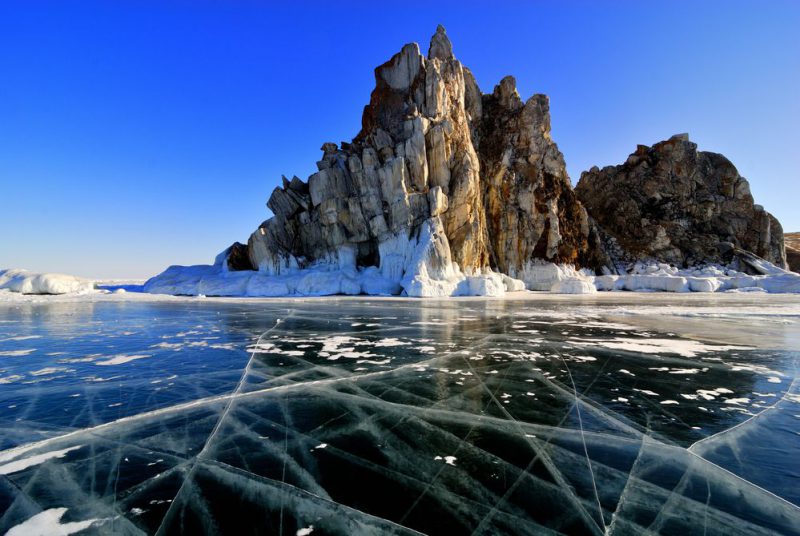
Baikal in numbers
Lake Baikal is located in the center of Asia, at the border of the Irkutsk region and the Republic of Buryatia. Its deepest spot reaches as deep as 1,637 m. Оnly two other lakes in the world have such a depth of more than 1,000 meters: Tanganyika in central Africa (1,470 m) and the Caspian Sea (1,025 m).
336 rivers and streams flow into Baikal, and only one river flows out – the Angara.
The lake is 636 kilometers long, its width varies from 20 to 80 kilometers. Its surface area is more than 31 thousand square kilometers which is approximately equal to the area of such countries as Belgium, Netherlands or Denmark. By the surface area, the Baikal ranks at the sixth place among the largest lakes in the world. The length of its coastline is about 2,100 km.
Lake Baikal stores almost a quarter of the world’s freshwater reserves. Its waters are famous for being the cleanest and most transparent in the world. In winter, when the lake freezes, individual stones and various objects are visible at a depth of 40m. In summer and autumn, when a mass of plant and animal organisms develop in sun-heated water, its transparency decreases to 8-10m.
The shores of lake Baikal continue to spread by about two centimeters per year. According to scientists, instead of becoming old and dying, like most lakes, the Baikal actually can grow into a new ocean. Baikal already looks like an ocean with its deep-sea basins, high waves, storms, and significant magnitudes of magnetic anomalies.

Baikal as a living organism
Today 1,850 species of animals and 850 species of plants find their home in lake Baikal and on its shores, many of them are endemic, i.e. found only on Lake Baikal.
The main wealth of Lake Baikal is in the abundance of various species of fish. The first place amongst them is occupied by omul, whitefish, grayling, ob, roach, sturgeon, taimen, lenok, burbot, perch, ide, pike, and roach. Another fish that is commonly found on Lake Baikal is called the golomyanka (Callianimus baicalensis). This is a transparent fish without scales and a swimming bladder whose body is composed to 35% of fat. The length of females of the golomyanka reaches 25 cm, males – up to 16 cm.
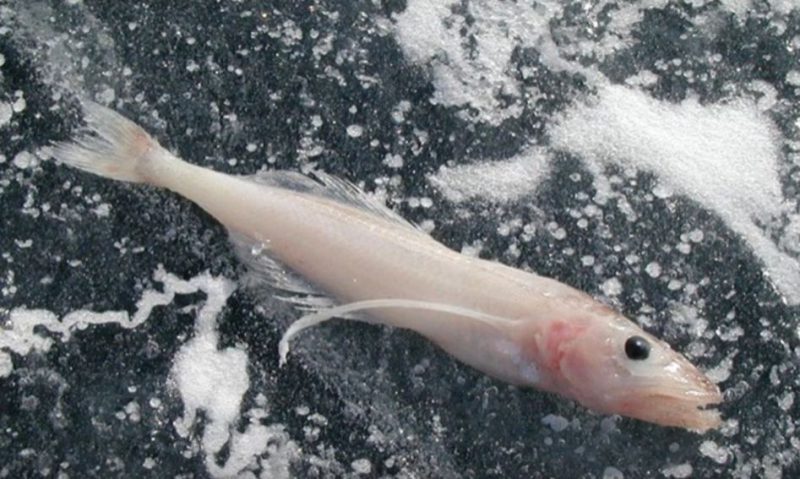
Another recognizable symbol of Baikal is the Baikal seal (nerpa) whose commercial capture is prohibited. The nerpa is the only mammal living in the waters of the “Siberian Sea”. This is one of the three freshwater seals in the world. Like most species living in the lake, the Baikal nerpa is endemic to the region. Its diet consists mainly of golomyanka fish. It is a very sweet, harmless and extremely photogenic creature.
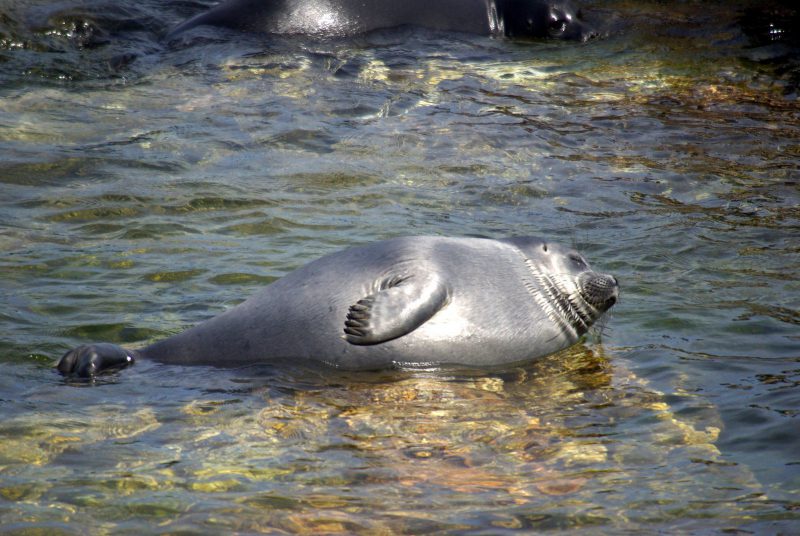
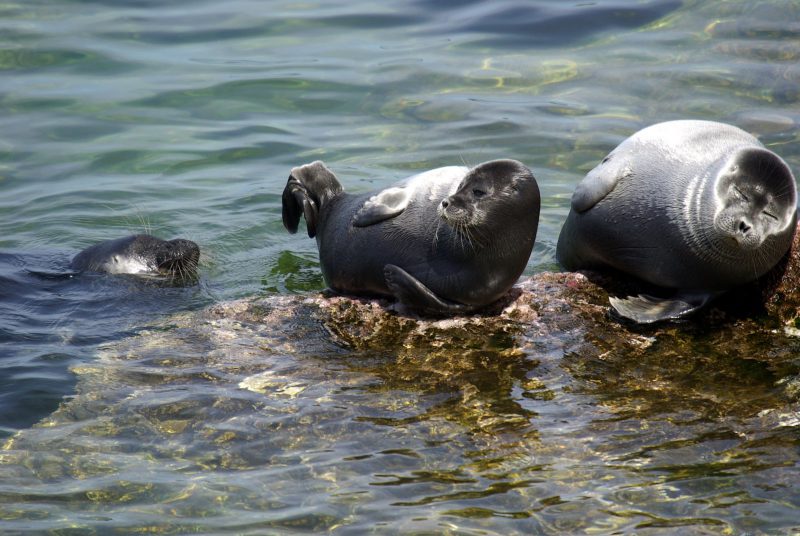
The Baikal’s water is low mineralized and rather cold. In August, at shallow depths, the water warms up to 13-17 degrees, and at a depth of over 1600 meters, the temperature reaches only 3.2 degrees. However strange, most living organisms live exactly in these bottom layers with the greatest depths, high pressure, and low temperatures. There are more than 1,000 species of cold-resistant algae in Baikal, which – as well as invertebrates and bacteria – purify water. They oxidize pollutants by absorbing oxygen from the atmosphere. As a result, carbon dioxide is released back into the atmosphere. The lake breathes like a living creature.
Often during severe winter frosts, cracks start breaking the surface ice into separate fields. The length of such cracks reaches 10-30 km, and the width is 2-3 m. Breaks occur annually in approximately the same areas of the lake. They are accompanied by a loud bang, resembling peals of thunder or gunfire. To a person who is standing on ice at that moment, it seems like the ice is breaking just under his feet and he will now fall into the abyss. But thanks to these cracks in the ice, the fish in the lake do not die from a lack of oxygen. Sun rays penetrate easily through the transparent Baikal ice, therefore, planktonic algae that produce oxygen rapidly develop in the water.
Mysteries of Baikal
The crystal waters of Lake Baikal conceal many mysteries. Some legends and stories about the lake maneuver on the brink of mysticism and real stories. For example, researchers have discovered at the bottom of Lake Baikal many meteorite debris and inexplicable linear locations of underwater stones. Some believe that the waters of the lake store the Pandora’s box. Others claim that Kolchak’s gold reserves and Genghis Khan’s gold reserves are hidden right there. There are also witnesses who claim that a UFO track passes over the lake.
The Baikal ice presents scientists with many mysteries. In the 1930s, specialists discovered unusual forms of ice that are only to be found in Lake Baikal. For example, cone-shaped ice hills up to 6 meters high, hollow inside. They resemble ice tents, open in the direction opposite to the shore. These hills can be located separately, and sometimes they form miniature “mountain ranges”.
Local residents, fishing in their boats in the lake, have repeatedly seen realistic mirages. The most common of them are castles, ancient ships and islands. Scientists explain this phenomenon very simply: the deep waters of the lake never warm up, remaining cold even in the hot summer, and the air above the smooth surface is warm, which creates a resonance. Different in density, the layers of air refract the sunrays, a phenomenon that forms pictures. Locals call them “holomenitsa”. This is a phenomenon on Lake Baikal, when on the horizon you can see objects that are actually 40 kilometers away.
On the island of Olkhon (the largest island of Lake Baikal), not only are there mirages, but also a scary funnel which forms spontaneously regardless of meteorological conditions. To see it, you need to move in a southeast direction from the island, about 30 kilometers from it there is a place called the Devil’s Funnel. A couple of times a year, in full calm, the elements here begin to rampage forming a rotating column of water. Scientists offer several versions of the origins of this phenomenon. One of them is based on the assumption that local dips in the bottom of Lake Baikal get quickly filled with water which leads to the formation of a whirlpool on the surface. According to another theory, two local countercurrent flows collide at the spot of the formation of the funnel. The directions and strength of these currents depends on the time of year and weather, so under certain conditions, water flows move strictly towards each other. Such an interaction of countercurrents can indeed lead to very powerful whirlpools.
Satellite images of the Baikal on spring ice sometimes show dark rings between 5 and 7-kilometer wide. Presumably, the formation of these circles is associated with emissions of natural combustible gas (methane) from the multi-kilometer sedimentary thickness of the bottom of Lake Baikal. In summer, in such places bubbles rise from the depths to the surface, and in winter, where ice is very thin or absent, circles are formed with diameters from half a meter to hundreds of meters.
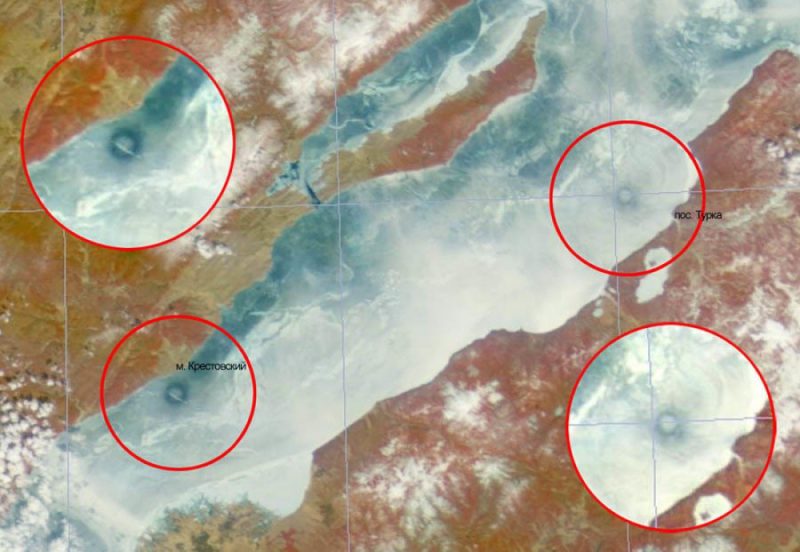
Baikal as the center of shamanism
Not only is Lake Baikal one of the most beautiful places on Earth, but also one of the most mysterious and sacred. A huge layer of culture and history of the peoples, who lived here and still live, distinguishes Baikal and the region around it. An important link that defines many aspects of the life of the indigenous peoples living in the Baikal region is shamanism – the traditional religion of the Buryats and other endemic peoples.
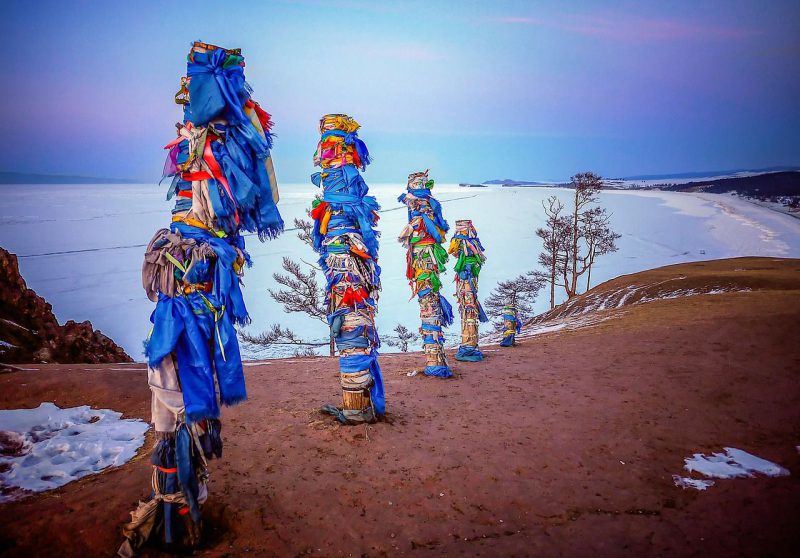
Despite the prohibitions and persecution during the Soviet era, shamanism survived in a transformed form in the Baikal region, primarily amongst ethnic Buryats. At the end of the twentieth and beginning of the twenty-first century, the shamanistic system of values began to revive widely. First of all, this is due to the fact that people need the spirituality there are missing in their lives. And shamanism is a clear system of spiritual values, built primarily on the knowledge of one’s own kind, its roots, oriented towards harmonious coexistence with the outside world.
The shamanistic gods urge you to love Earth and nature as a part of it, because it will answer you by giving everything you need to live on the planet like in your own home.
The shamanistic gods say preach that the main problems of modern people are related to the fact that mankind started to believe in the idea of superiority. It separated itself from the rest of the living world, from nature, from its ancestral ancestors, from its past, from Mother Earth and Father Heaven.
Baikal as a center of tourism
The marvelous nature of Lake Baikal, a quite mild for Siberia climate, and sandy beaches attract tourists from all over the world. There are ski slopes, comfortable hotels and resorts, healing springs. Cruises, ethnographic and environmental tours, horseback riding, hunting and fishing are awaiting tourists. The bulk of tourists come in the summer, which is quite warm here.
The best way to travel around the lake is in a small rented boat, having the ability to change the route as you wish, go to picturesque bays and straits, to fish and to sunbathe.
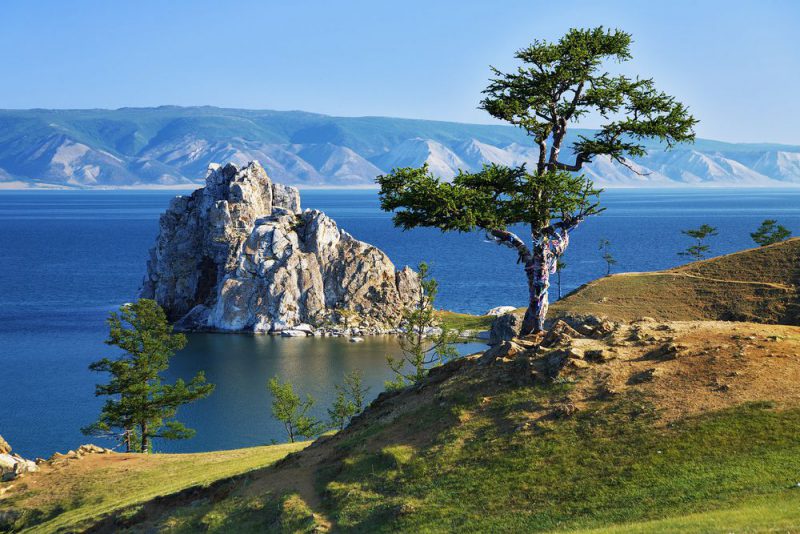
Due to the constant seismic activity in the mountains around the lake, there are many geothermal springs in the area. Hot springs in the Severobaikalsk area are very popular among tourists. The water temperature there varies between 44 and 50 degrees. The chemical composition is different everywhere which means that you can choose a healing bath based on the needs of your body.
Untouched places with wildlife attract lovers of freeriding and mountain hiking from late October to early March.
Scuba diving with equipment in the Baikal “sea” is practiced both in summer and in winter. The most favorable time for this is June when the water is most transparent, there is a lot of light, and underwater currents are weak. The Baikal waters hide not only the rich animal and vegetable underwater world, but also the relief variety – grottoes, vertical walls, canyons.
Wildlife lovers are attracted by the Ushkany islands, where Baikal seals organize their breeding-grounds.
An interesting energy center of these region is the Olkhon Island. It is called the “heart of Lake Baikal”, even its shape resembles the shape of a lake. This is the largest island on Lake Baikal, its length reaches 71 kilometers and a width of 12 kilometers. Near the northeast coast of Olkhon there is the deepest place in Lake Baikal (1,637 meters). Locals believe that in the cave of the marble rock Burkhan lies the grave of Genghis Khan. Myths and legends call the island of Olkhon “the abode of the terrible spirits of Baikal”. In the late 1990s, the shamans of the Republic of Buryatia officially recognized the island of Olkhon “as the main sanctuary, cult center of common Mongolian and Central Asian significance, personifying the sacred ancestral home of the Buryats”.
There is another attraction near Baikal, man-made this time. Its name is the Circum-Baikal Railway. This historic railway in the Irkutsk region used to be called the “gold buckle” of the steel belt of Russia. In the past, it was a part of the Trans-Siberian Railway with a length of 94 kilometers. Now it is a kind of museum of railway architecture, including 806 monuments of cultural heritage, 582 engineering monuments, 38 tunnels and more than 200 bridges.
To the West of Baikal, on the Belaya River, there are Maltinskaya and Buretskaya sites of an ancient man. The age of these monuments is estimated to date back 25 thousand years. On the shore of the lake, on the cliff of Sagan-Zaba, numerous rock paintings have been preserved. The earliest of them dates from the end of the second millennium BC.
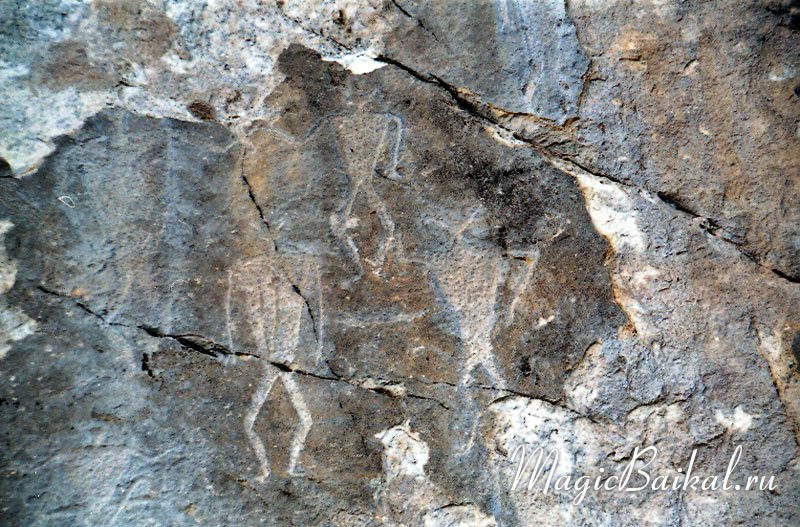
The most visited vacation spots in the region are: the Circum-Baikal Railway, Sandy Bay, Listvyanka, the coast of the Small Sea, the west coast of Olkhon, and the coast near the city of Severobaykalsk. Other places that can be reached by SUV are also popular.
There are more sunny days on the lake than on the resorts of the southern seas. However, in the fall, storms with strong winds are frequent. The Baikal freezes over only in the second half of January, and is completely freed from ice only in May.
An important condition for a safe holiday on Lake Baikal is a detailed plan of the travel route. You can get to Lake Baikal from Moscow by plane or train. There are direct flights to Irkutsk (Irkutsk airport) and Ulan-Ude (Baikal airport). Flight to these cities will take about 6 hours, while the journey takes about 4 days by rail.
For those who would like to combine a trip to Lake Baikal with learning the Russian language, Immersion in Russia can provide you with this opportunity.






